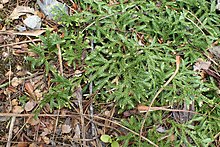| Diphasium scariosum | |
|---|---|

| |
| Scientific classification | |
| Kingdom: | Plantae |
| Clade: | Tracheophytes |
| Clade: | Lycophytes |
| Class: | Lycopodiopsida |
| Order: | Lycopodiales |
| Family: | Lycopodiaceae |
| Genus: | Diphasium |
| Species: | D. scariosum |
| Binomial name | |
| Diphasium scariosum (G.Forster) Rothm. | |
| Synonyms | |
| |
Diphasium scariosum, synonym Lycopodium scariosum, commonly known as spreading clubmoss or creeping club moss, is a species in the club moss family Lycopodiaceae. The genus Diphasium is accepted in the Pteridophyte Phylogeny Group classification of 2016 (PPG I), but not in other classifications which submerge the genus in Lycopodium.
Description
Diphasium scariosum has main stems that lie flat along the ground and which spread to more than a meter long. The branchlets are 0.5 m tall, have two different surfaces and are very branched. The leaves are dimorphic and are yellowish green. The first leaf form occurs on the upper leaves of the plant, which are in two alternating rows and have been flattened into one plane. The upper leaves are 3–5 mm long, 1–1.5 mm wide and are oval. The second leaf form are the lower leaves which are in two rows but have not been flattened into one plane. These leaves are scale-like, are only 0.2 mm long and have translucent membranous dilated tips. D. scariosum has distinctive colouring with big fluorescent spots throughout. This is unusual for a club moss as not many club moss species have 5-O-glucosides of flavones, which cause these bright fluorescent spots. D. scariosum has solitary erect strobili which grow 1-3 cm long. The sporophylls overlap each other, are oval, straw-like, and have membranous tips. Genera of the Lycopodioideae subfamily, which includes D. scariosum, differs from the Lycopodielloideae sensu genera by the presence of pedunculate strobili with modified sporophylls in them.
Natural global range
Diphasium scariosum occurs naturally in the Philippines, New Guinea, Borneo, Australia, New Zealand and the Subanatarctic islands. In New Zealand, Diphasium scariosum is found throughout the North Island but is less common in Northland. It is also found throughout the South Island.
Habitat
Diphasium scariosum is found in coastal to subalpine environments in mossy roadside banks, shrubland and peaty ground. D. scariosum prefers well-drained clay or peaty soils.
Life cycle and phenology
Diphasium scariosum is a pteridophyte. When the spores are released from the sporophyll and the strobili, they can take seven or more years to turn into a gametophyte which can then survive for 10 or more years. The lifecycle of a Lycopodium species can take up to 20 years to complete. D. scariosum reproduces sexually in unfavourable conditions or asexually in favourable conditions. When D. scariosum is not producing spores, it grows laterally along the ground.
Diet and foraging
Diphasium scariosum occurs on peaty, nutrient-rich soils. D. scariosum requires soils with high nutrient contents from dead organic matter but does not tolerate very wet soil.
Predators, Parasites, and Diseases
Clubmosses are eaten by slugs and snails, and is parasitised by fungi, although this has not yet been documented for D. scariosum. D. scariosum was found to be infected with mycorrhizal fungi, which likely benefits the plant.
References
- ^ Hassler, Michael & Schmitt, Bernd (November 2019). "Diphasium scariosum". Checklist of Ferns and Lycophytes of the World. 8.11. Archived from the original on 2017-09-02. Retrieved 2019-12-08.
- PPG I (2016). "A community-derived classification for extant lycophytes and ferns". Journal of Systematics and Evolution. 54 (6): 563–603. doi:10.1111/jse.12229. S2CID 39980610.
- Christenhusz, Maarten J.M. & Chase, Mark W. (2014). "Trends and concepts in fern classification". Annals of Botany. 113 (9): 571–594. doi:10.1093/aob/mct299. PMC 3936591. PMID 24532607.
- ^ Chinnock, RJ (1998). "Lycopodiaceae" (PDF). Flora of Australia, Ferns, Gymnosperms and allied groups. 48: 66–85.
- ^ De Lange, P.J. "Diphasium scariosum". New Zealand Plant Conservation Network. Retrieved 2024-04-01.
- ^ Markham, Ken R.; Moore, Noreen A.; Given, David R. (1983). "Phytochemical reappraisal of taxonomic subdivisions of Lycopodium (Pteridophyta-Lycopodiaceae) based on flavonoid glycoside distribution". New Zealand Journal of Botany. 21 (2): 113–120. doi:10.1080/0028825X.1983.10428534.
- Field, Ashley R.; Testo, Weston; Bostock, Peter D.; Holtum, Joseph A.M.; Waycott, Michelle (2016). "Molecular phylogenetics and the morphology of the Lycopodiaceae subfamily Huperzioideae supports three genera: Huperzia, Phlegmariurus and Phylloglossum". Molecular Phylogenetics and Evolution. 94: 635–657. doi:10.1016/j.ympev.2015.09.024.
- ^ "Creeping clubmoss, Lycopodium scariosum G.Forst (Species)". collections.tepapa.govt.nz. Retrieved 2024-04-01.
- Bower, F. O. (1903). "The Morphology of Spore-Producing Members". Botanical Gazette. 35 (4): 285–291. doi:10.1086/328346.
- ^ Nauertz, E.A; Zasada, J.C (1999). "Lycopodium: growth form, morphology, and sustainability of a non-timber forest product" (PDF). Forest Communities in the Third Millenium: Linking Research, Business, and Policy Toward a Sustainable Non-timber Forest Product Sector. USDA Forest Service Central Research Station General Technical Report NC-217: 110–115.
- Zainorabidin, A; Wijevesekera, D.C (2008). "Geotechnical characteristics of peat" (PDF). Proceedings of the AC&T: 71–78.
- ^ Benca, Jeffrey P. (2014). "Cultivation Techniques for Terrestrial Clubmosses (Lycopodiaceae): Conservation, Research, and Horticultural Opportunities for an Early-Diverging Plant Lineage". American Fern Journal. 104 (2): 25–48. doi:10.1640/0002-8444-104.2.25.
- Cooper, Karen M. (1976). "A field survey of mycorrhizas in New Zealand ferns". New Zealand Journal of Botany. 14 (2): 169–181. doi:10.1080/0028825X.1976.10428891.
External links
 Data related to Diphasium scariosum at Wikispecies
Data related to Diphasium scariosum at Wikispecies
| Taxon identifiers | |
|---|---|
| Diphasium scariosum | |
| Lycopodium scariosum | |
| Diphasium decurrens | |
| Lycopodium decurrens | |